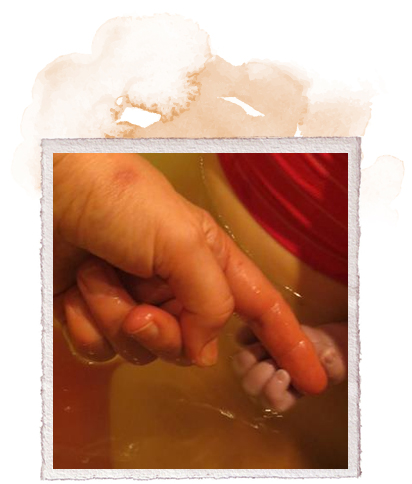

INFORMATION TO BE USED AT YOUR OWN RISK.
Any suggestions or opinions voiced in these pages are those of the authors, and in no way to be constructed as final treatment advice. They are intended as a starting point to develop your own preparation and treatment plan. Please consult your medical and/or psychological experts or caregivers to fine-tune the advice and suggestions for your own unique needs.


FACING FEARS
FACING AND CONQUERING PREGNANCY AND CHILDBIRTH FEARS
Congratulations on your pregnancy. Whether your pregnancy was planned or
unplanned, your commitment to having this baby signals that you have decided
to accept responsibility for a new life, and in your own way agreed to contribute
to the future of our world. Pregnancy heralds a time of ambiguity that can
sometimes, in addition to being exciting, be quite confusing and overwhelming.
Not only does the addition of a new member to the family add new excitement
in our lives, but it may also presupposes change on a number of levels – your
identity, social behaviour, financial status and many more. Each stage of
pregnancy also seems to come with a unique set of fears and concerns for the
health and wellbeing of the mother and baby alike. This type of anxiety and
anticipation is normal and healthy and inseparable of the pregnancy and
childbirth experience, but should not paralyse you with fear.
It has been indicated that to be fearful of childbirth could affect the process of
birth and recovery adversely. This is referred to as the Fear-Tension-Pain
syndrome.
FEAR > TENSION > PAIN
If the mother-to-be is fearful, the fear creates tension in her body and muscles. When the muscles are tense, they are not able to relax and flex as is necessary for natural childbirth. This causes unnecessary pain and discomfort for the mother, and might even prolong the process of labour.
The experience of fear is also the precursor for biochemical changes in the body, such as the increased secretion of the stressor hormone, cathecholamine, which prepares the body to enter the ‘fight, flight or freeze’ response. When the body goes into this defensive mode, the pupils are dilated, the speed and force of the heart rate is increased, activities such as digestion is suspended, and the arteries that go to organs (e.g. the uterus) that are not essential for defence, are closed. A woman in labour cannot fight the inevitability labour, nor can she run away. If she has unresolved fears or experiences extreme anxiety during labour, her body will therefore choose the last remaining option, namely to freeze. The limited oxygen and blood supply to the uterus impedes the effective functioning of the uterine muscles in opening the cervix, and the oxygen supply to the baby could be hindered
By learning to embrace your worries and concerns about the pre and post-birth experience and learning new tools for physical and emotional coping, you can learn to manage your fears and create positive experiences and memories to treasure.
ACKNOWLEDGING AMBIGUITY:
It is often our unspoken concerns that generate the most distressing emotions. It is time to face ‘the monsters in the cupboard’ and do something about them. Both mom and dad-to-be need to take note of their own comfortable and uncomfortable feelings, thoughts and concerns they have about becoming parents, and be able to discuss it with each other without try ‘solve’ problems. This increases intimacy and provides relief.
CONTROLLING THE IMPACT EVENTS HAVE ON YOUR LIFE
Our experience of being in this world is largely determined by the meaning we attach to events. Events in themselves are mere facts, and have no influence over us. It is what we make of what happens that determines the impact of these events on our lives.
A > B > C
Activating event Belief / meaning Consequence (Emot/phys/beh)
We have the power to control or manage our emotional, physiological and behavioural responses to any event in our lives, through the beliefs we hold. There are some things in this world we can control and change, and other things we have to accept we are powerless to control, but our interpretations of events are surely one of the things we can control.
Our beliefs about the experience of childbirth, and the flexibility or rigidity of these beliefs, will therefore determine the quality and memory of the experience.
What do you believe about?
- The presence and experience of pain in childbirth?
- The parents’ role in the birthing process?
- Creating expectations for the desired course of childbirth?
- What constitutes a successful birthing experience?
HOW TO CREATE POSITIVE EXPECTATIONS THROUGH USE OF AFFIRMATIONS
An affirmation is any statement that people make, that their subconscious minds, as obedient servants, follow. Affirmations, especially when repeated frequently, open channels in our consciousness to create our desired realities. Therefore, affirmations that are used consistently eventually turn into beliefs people hold about themselves, others and the world and these ingrained beliefs always produce results, sometimes in ways we cannot even imagine. Affirmations have the ability to turn negative thoughts into positive ones – this is especially important for the birthing process when thoughts may become unconstructive due to fatigue, anxiety and frustration.
HOW TO CREATE AFFIRMATIONS
Affirmations should be positive statements about how you would like your life to be, and always made in the present tense.
List things that are wrong with you or that you would like to change and create them into positive affirmations, e.g. “My life is a mess” or “I should lose weight” becomes “I am in the process of making positive changes”.
Repeat affirmations frequently. Affirmations can be said or sung anywhere and at any time. You can look at yourself in a mirror as you repeat these affirmations out loud and look yourself in the eyes. You can also write out your affirmations 10 or 20 times a day. Try taping your affirmations and play the tape when taking a rest as relaxation allows easier access to the subconscious.
Remember, your subconscious believes every word you say – choose your words carefully and be specific about the meaning of words.
It is known that a baby inside the womb can respond to a mother’s feelings and agitations. It is also known that the baby inside the womb already learns and forms beliefs about self, others and the world on a subconscious level. Affirmations can be used to bond with your unborn child and give your child the best start in life. Using affirmations is a way for you to communicate with your child’s subconscious awareness.
What beliefs would you like your child to hold about him/herself, the world and others as s/he enters the world, e.g.
- You can grow at your own pace
- We love you and welcome you into our family

